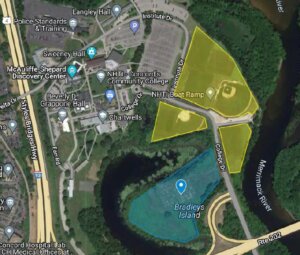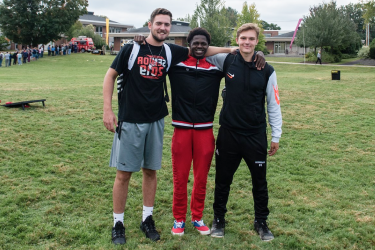Unmanned Aerial Vehicle (Drone) Policy
Policy Purpose
To provide all persons on NHTI property guidance on the use and operation of all unmanned aircraft systems (UASs) and amateur rockets to comply with Federal Aviation Administration (FAA) regulations, and New Hampshire state laws, while ensuring that all institutional, legal, public safety, and ethical responsibilities are met.
Policy Summary
To provide guidance to anyone possessing or operating UAS (drone) or amateur rocket on NHTI property. This policy comprises FAA, state, and local rules and regulations that govern UAS/amateur rocket use along with specific college guidance and sanctions for violating this policy. NHTI is the property owner and is in control of the land of the campus; however, the airspace is controlled by the FAA. Anyone who may be authorized to fly a UAS/amateur rocket is responsible for flying within FAA rules and regulations, amateur rocket safety guidelines, state law, and college policies.
Policy Statement
UASs can provide significant contributions to college research and service/outreach in a variety of disciplines. Additionally, aerial photography with a UAS can potentially assist in academics (study, research), land management, athletics, law enforcement, and other support functions. UAS-related laws, rules, and regulations continue to evolve, and a well-documented public concern regarding the use of a UAS is in relation to individual privacy rights.
Key Definitions
Key FAA definitions applicable to this policy:
- Amateur Rocket – An unmanned rocket that:
- Is propelled by a motor or motors having a combined total impulse of 889,600 Newton-seconds (200,000 pound-seconds) or less
- Cannot reach an altitude greater than 150 kilometers (93.2 statute miles) above the earth’s surface
- Low Altitude Authorization and Notification Capability (LAANC) – A collaboration between the FAA and industry; directly supports UAS integration into controlled airspace at or below 400 feet, provides awareness of where pilots can/cannot fly, and provides air traffic personnel where drones are/are not flying; can be automatically applied in airspace through apps such as Aloft and B4Ufly.
- Small Unmanned Aircraft – An unmanned aircraft weighing less than 55 pounds on takeoff, includingeverything that is onboard or otherwise attached to the aircraft
- Small Unmanned Aircraft System (small UAS) – A small unmanned aircraft and its associated elements(including communication links and control components) required for its safe and efficient operation in the national airspace system.
- Unmanned Aircraft – An aircraft operated without the possibility of direct human intervention from within or on the aircraft
- Unmanned Aircraft System – An unmanned aircraft and its associated elements (including communication links and control components) required for its safe and efficient operation in U.S. airspace.
Applicability of Policy
All individuals possessing and/or operating a UAS or amateur rocket on NHTI property are subject to these regulations.
Key FAA Laws and Regulations
14 CFR Part 107 Small Unmanned Aircraft Systems governs the use of small UAS (under 55 pounds).
Exception (49 U.S.C. § 44809) allows the flying of drones for recreational purposes (under certain conditions) without complying with Part 107. To fly under the statutory exception, you must comply with all portions of Section 44809, including flying your drone for recreational purposes.
Types of UAS Operators identified by the FAA
The FAA identifies through federal law and regulations four types of UAS operators:
- Recreational flyers and modeler community-based organizations
- Certified remote pilot or commercial operator
- Public safety and government user
- Educational user
Recreational Flyers and Modeler Community-Based Organizations
Recreational flight is flying for fun or personal enjoyment. Recreational flight is one that is not operated for a business or any form of compensation. Financial compensation, or the lack of it, is not what determines if the flight is recreational or commercial. When in doubt, fly under Part 107. Non-recreational purposes include, but are not limited to:
- Taking photos to help sell a property or service
- Roof inspections
- Taking pictures of an athletics event game for the organization/school’s website
- Goodwill or other non-monetary value can also be considered indirect compensation, including volunteering to use a UAS to survey coastlines for a non-profit organization
Rules for recreation fliers can be found here: Recreational Flyers and Modeler Community-Based Organizations
Certified Remote Pilot or Commercial Operator
A small drone that is less than 55 pounds can be flown for work or business by following the Part 107 guidelines. To fly under Part 107 rules, there are four main steps:
- Learn the rules.
- Become a certified drone pilot by passing the knowledge test.
- Hold a remote pilot license and have it in good-standing.
- Register your drone with the FAA under Part 107.
Rules for certified remote pilot or commercial operator can be found here: Certificated Remote Pilots including Commercial Operators
Public Safety and Government User
Public safety/law enforcement personnel may operate a UAV on NHTI property under the following conditions:
- Under 14 CFR part 107, the small UAS rule
- Under the statutory requirements for public aircraft (49 U.S.C. §40102(a) and § 40125). Operate with a Certificate of Waiver or Authorization (COA) to be able to self-certify UAS and operators for flights performing governmental functions.
Educational User
Statutory provision (P.L. 115-254, Section 350, as amended by P.L. 116-283, Section 10002) clarifies that education and research uses of UAS for Institutions of Higher Educations can for educational purposes can be operated under the rules for recreational flyers.
Authorization to Fly a UAS on NHTI Campus
Airspace over NHTI is designated as controlled airspace for the Concord-Padgett Regional Airport (Designation: KCON) with a designated ceiling of zero (0) feet without coordination with the Concord-Padgett Regional Airport. Automatic authorization is not granted through LAANC.
Prior to operating any UAS on NHTI property for any reason, in the designated flight areas authorization must be granted by the FAA. To obtain authorization visit FAADroneZone and create an airspace authorization request.
Campus Safety Department Approval Process
UASs must be registered with Campus Safety prior to use to verify compliance with FAA guidelines and provide drone policy. The following will be confirmed and/or verified:
- Drone is registered per FAA guidelines. Register at: FAADroneZone
- Completion of required tests/certifications:
- Recreational users: Recreational UAS Safety Test (TRUST)
- Certificated remote pilots/commercial operators: Knowledge Test
- Drone is marked with registration number per FAA guidelines.
- Drone pilot has confirmation of airspace authorization from the FAA.
- Commercial operators shall provide a copy of certificate of insurance (COI)
- Effective Sept. 16, 2023, all UAS operators must comply with the FAA Remote Identification for Drone Pilots.
UAS operators will be provided a permit for drone usage for a specified period. This does not absolve the UAS operator of their responsibilities to operate a UAS under the “Rules” section below. NHTI is not responsible for damages and/or injuries caused by UAS operators.
Rules for UAS Operators on NHTI Property
- Once all necessary documentation is verified and a permit is issued all UAS operators must adhere to the following:
- All recreational pilots must follow guidelines for recreation flight, which can be found at Recreational Flyers and Modeler Community-Based Organizations.
- All commercial pilots must follow guidelines for recreation flight, which can be found at Certificated Remote Pilots including Commercial Operators.
- UAS must be registered according to FAA guidelines.
- UAS must not weigh more than 5 pounds for recreational flyers and 10 pounds for certified remote pilots/commercial operators.
- UAS cannot be flown beyond line of sight and must be observed at all times; a second person co-located with the operator can be an observer.
- UAS may not rise higher than flight ceiling allowed per Concord-Padgett Regional Airport or the FAA.
- UAS must not have metal blade propeller.
- UAS must not be flown directly over unprotected people, vehicles, property, and structures except as provided for in the operation of Unmanned Aircraft Systems over people final rule.
- UAS is not to be flown in a reckless or careless manner or under the influence of alcohol and/or drugs.
- Operating UAS beyond the established designated perimeters is strictly prohibited.
- Using a UAS on campus to harass and/or stalk an individual, violate an individual’s privacy, disrupt college operations, or as applicable with provisions described in workplace policies and the Student Code of Conduct is prohibited.
Authorized UAS Drone Usage Areas

The blue-shaded perimeter demarks general use at any time with approved permission as outlined above.
The yellow-shaded perimeter is the secondary area for use by NHTI personnel during athletic events and for general use when there is no scheduled activity for the athletic fields with approved permission as outlined above.
The director of Campus Safety or their designee may allow for use of an UAS outside of the designated perimeters and requirements of this policy.
Amateur Rockets
Use of amateur rockets on NHTI property is authorized for classes/events sponsored by NHTI, the McAuliffe-Shepard Discovery Center, or specific organizations that have requested usage of space through a Function Request Form. Individuals are not authorized to use NHTI property for personal rocket launches.
The use of amateur rockets on NHTI property must comply with FAA requirements, National Association of Rocketry Safety Codes, and this policy. Amateur rockets will be limited to Class 1 model rockets. FAA coordination is required for Class 1 model rockets.
For more information on these requirements see the Understanding FAA Regulations page on the National Association of Rocketry Safety webpage.
Process for Use of Amateur Rockets on NHTI Property
Prior to the use of any amateur rocket on NHTI property, coordination must be conducted with NHTI’s Campus Safety to ensure safety requirements are met.
- Submission of a Function Request Form request by faculty member or event organizer
- Submission of COI for non-campus organizers
- Coordination and determination of site for rocket launches, with determination based on rocket type(s)being launched
- Review of safety plan and types of amateur rockets to be used
Because of propellent used, amateur rockets are prohibited inside buildings as follows:
- Academic buildings, unless for educational purposed where propellent is removed and rocket is inert
- Residential halls at all times
Policy Enforcement
NHTI’s Campus Safety shall ensure compliance with and will address violations of this policy. FAA, safety, other regulatory violations, or violations of this policy that are reported or observed during the use of an UAS or amateur rockets on NHTI property will be immediately required to cease UAS/amateur rocket operations and shall result in the following:
- Students may be referred to Student Conduct under the requirements of the Student Code of Conduct.
- Employees may be referred to Human Resources under applicable workplace polices.
- Vendors, contractors, and event organizers may be prohibited from doing so in future.
- General public will be documented and instructed to leave campus.
Campus Safety is a public safety organization and may report those in violation of FAA rules and regulations to the FAA Law Enforcement Assistance Program (LEAP), state, or local law enforcement officials.
- Student Services
- IT Services
- Dining
- How-To Videos
- Residence Life
- Wellness Resources
- Accessibility Services
- Campus Safety
- English for Speakers of Other Languages
- Student Handbook
- Residence Hall Refunds
- Parking and Traffic Policy and Procedures
- Personal Property
- Pet and Animal Policy
- Policy of Entry into Student Rooms
- RAVE Alerts
- Renters Insurance
- Research Involving Human Subjects Policy
- Residence Hall Damages
- Residence Hall Maintenance
- Residence Hall Payments
- NHTI Residence Hall Contract
- Residence Hall Terms of Agreement
- Smoking, Tobacco, and Tobacco Alternatives Policy
- Specific Residence Life Policies
- Student Code of Conduct
- Technology and Software
- Timely Warnings
- Title IX Sexual Misconduct Resources
- Unmanned Aerial Vehicle (Drone) Policy
- Use and Treatment of Residence Hall Premises
- Visitation and Guests in Residence Halls
- Firearms and Weapons Policy
- Alcohol and Other Drugs Policy
- Board
- Bulletin Boards
- CCSNH Collection Disclosure Clause
- Civil Rights/Equity (Affirmative Action)
- Communicable Disease Policy
- Disordered Eating Intervention Protocol
- Emergency Notifications
- Fines and Damages
- Fire Safety Policy
- Active Shooter Situations
- Fireworks Policy
- Gambling Policy
- Hazing Policy
- Inclement Weather
- Liability Policy
- Locker Policy
- Missing Student Policy
- Motto and Emblem
- New Hampshire Police Standards and Training Council
- Commencement
- Important Forms
- Career Resources
- Student Life
- Leadership Opportunities

Related Documents

Contact Us:
Student Affairs
603-230-4040
Fax: 603-230-9315
NHTIstudentaffairs@ccsnh.edu


